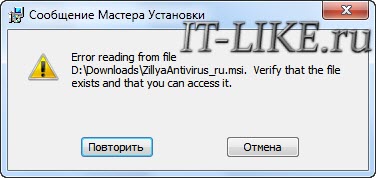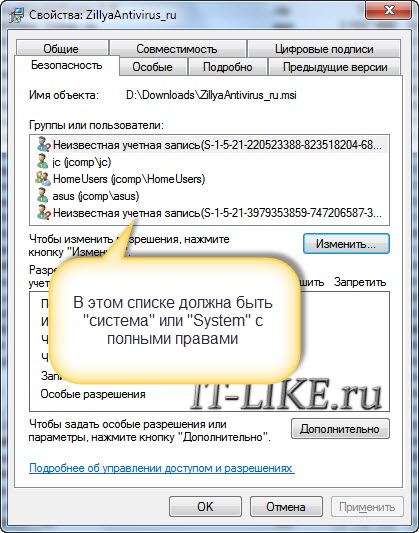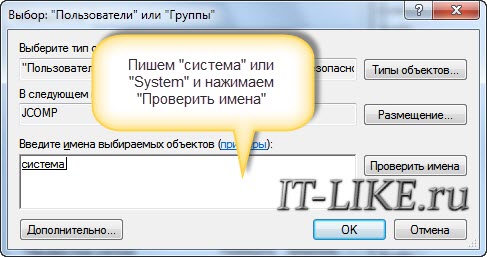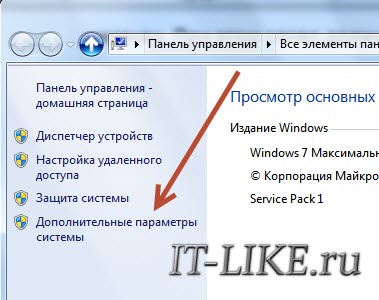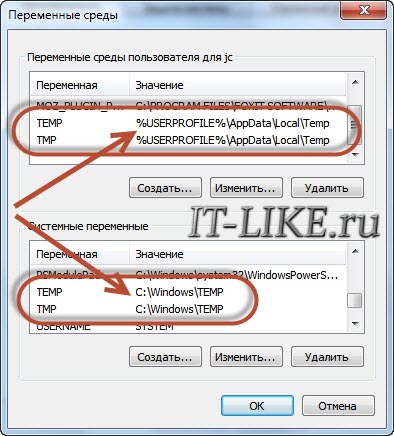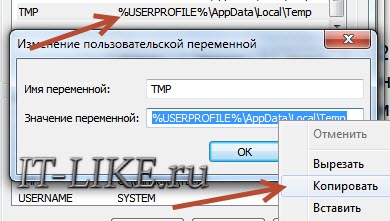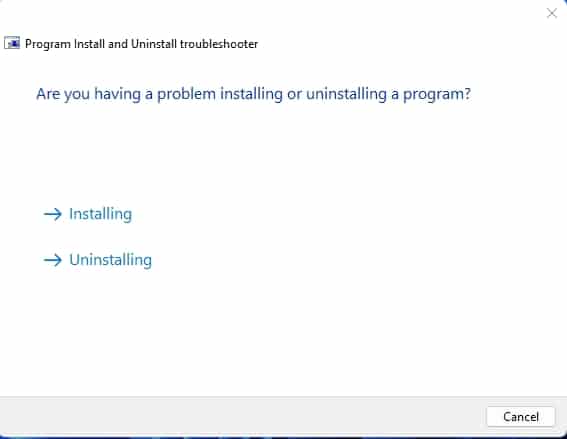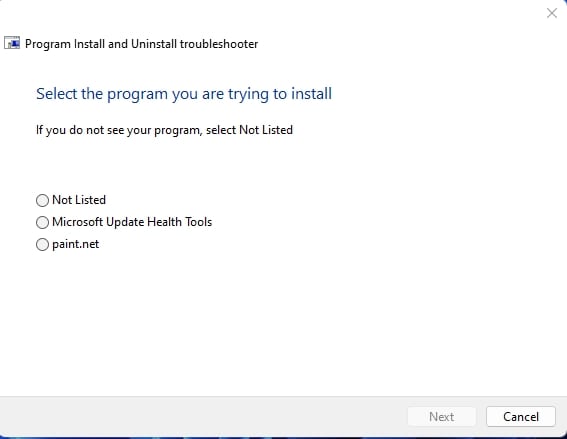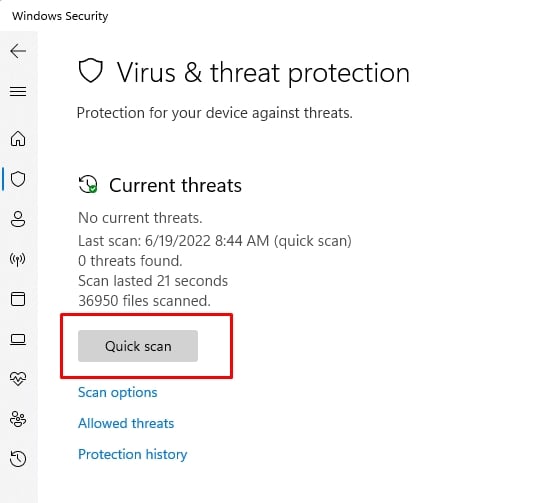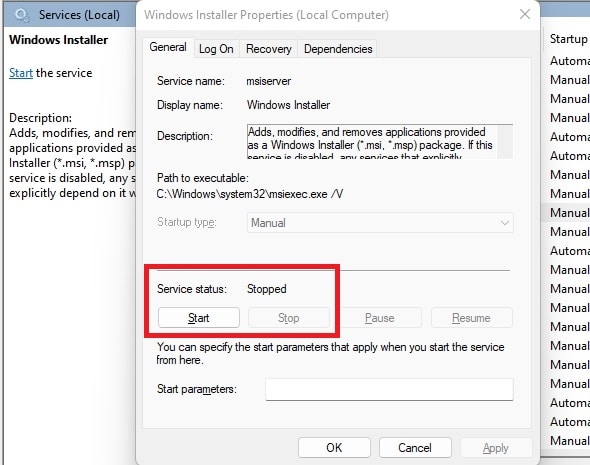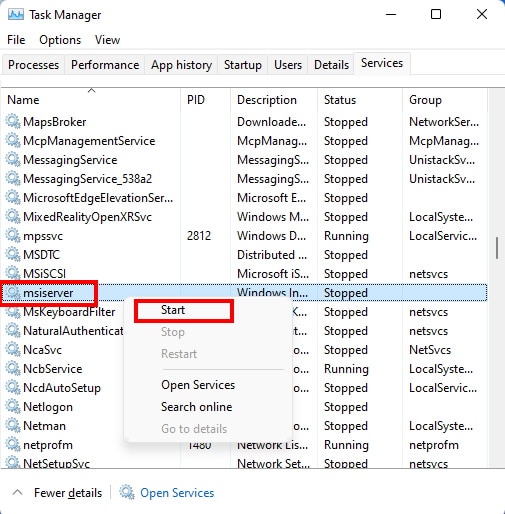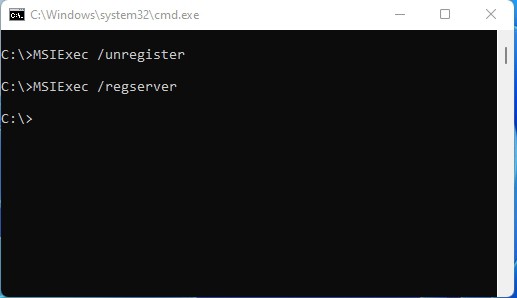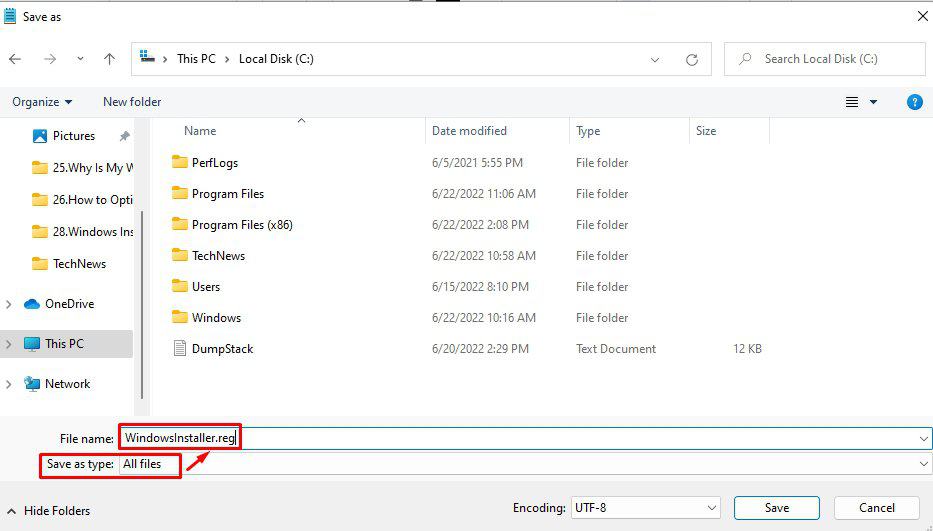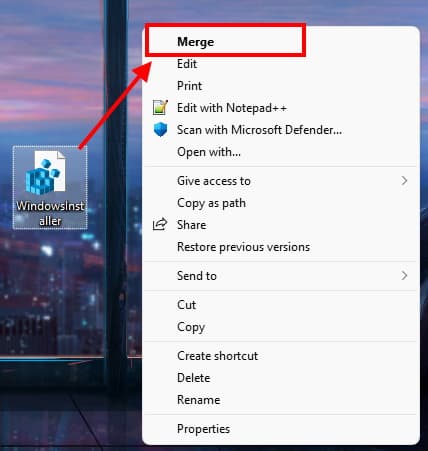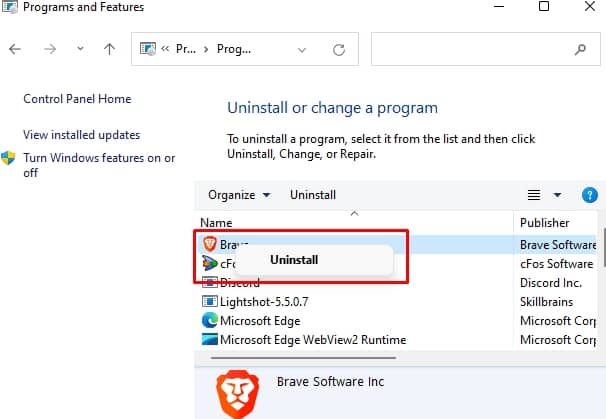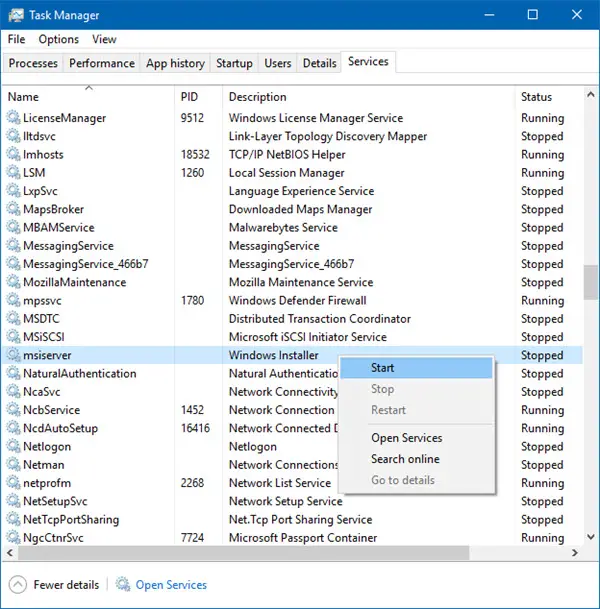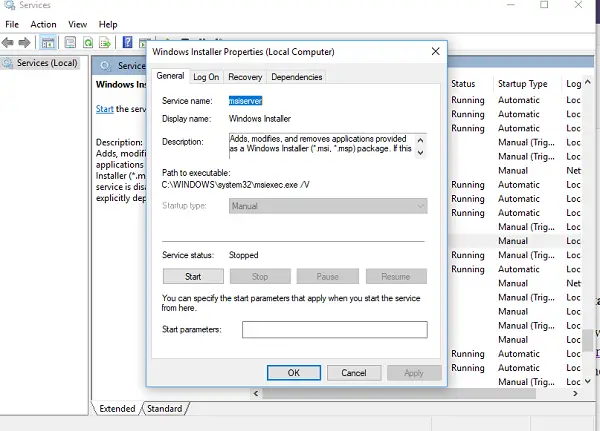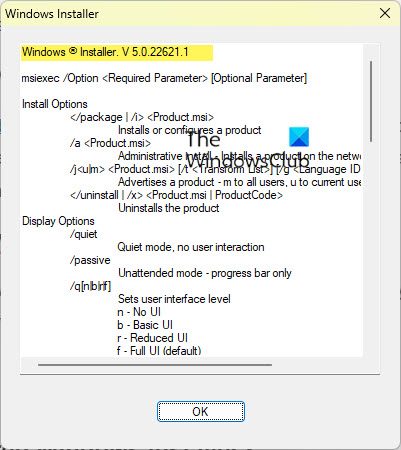Windows 7 Enterprise Windows 7 Home Basic Windows 7 Home Premium Windows 7 Professional Windows 7 Starter Windows 7 Ultimate Windows Vista Business Windows Vista Enterprise Windows Vista Home Basic Windows Vista Home Premium Windows Vista Starter Windows Vista Ultimate Microsoft Windows XP Home Edition Microsoft Windows XP Professional Microsoft Windows XP Starter Edition Windows Server 2008 Datacenter Windows Server 2008 Enterprise Windows Server 2008 Standard More…Less
Symptoms
When you install, uninstall, or update a program on a Windows-based computer, you may receive one of the following error messages.
Error message 1
The Windows Installer Service could not be accessed.
Error message 2
Windows Installer Service couldn’t be started.
Error message 3
Could not start the Windows Installer service on Local Computer. Error 5: Access is denied.
Resolution
To fix this problem automatically, run the «Fix problems that programs cannot be installed or uninstalled» troubleshooter to repair issues that block program installation or removal because of corrupted registry keys.
Important To perform many of the methods and steps in this article, you must be logged on to your computer as an administrator.
To determine whether you’re using an account that has administrator rights
To determine whether you’re using an account that has administrator rights, use one of the following methods, as appropriate for the operating system that you’re running.
Windows 7 and Windows Vista
-
Open the Date and Time dialog box.
-
Click Start.
-
Type the following command in the Start Search or Search programs and files box, and then press Enter:
timedate.cpl
The Date and Time dialog box appears.
-
-
Click Change date and time. When the User Account Control dialog box appears, click Continue.
-
Do one of the following, depending on what happens when you click Continue:
-
If your computer does not prompt you for a password, you are already logged on with an administrator account. Click Cancel two times to close the Date and Time dialog box. You are ready to fix the Windows Installer issues.
-
If your computer prompts you for a password, you are not logged on with an administrator account.
-
Windows XP and Windows Server 2003
-
Open the Date and Time dialog box.
-
Click Start, and then click Run.
-
Type the following command in the Run dialog box, and then press OK:
timedate.cpl
-
-
Do one of the following, depending on the result:
-
If the Date and Time Properties dialog box appears, you are already logged on as an administrator. Click Cancel to close the dialog box.
-
If you receive the following message, you are not logged on as an administrator:
-
After you’ve verified that you’re logged on to your computer as an administrator, you can start troubleshooting Windows Installer issues.
If the Windows Installer engine is corrupted, disabled, or installed incorrectly, this may cause program installation issues.
Use the following methods to identify any Windows Installer issues that may be causing problems when you install, uninstall, or update programs.
Method 1: Determine whether the Windows Installer engine is working
-
Click Start
, type cmd in the Search box or click Run then type cmd in the dialog (Windows XP or Windows Server 2003), and then press Enter to open a Command Prompt window.
-
At the command prompt, type MSIExec, and then press Enter.
-
If the MSI engine is working, you should not receive any error messages. If you receive an error message, enter the error message text into a search engine such as Bing or Google to locate troubleshooting information about the issue.
-
Try to install or uninstall again.
Method 2: Make sure that the Windows Installer service is not set to Disabled
-
Click Start
, type services.msc in the Search box or click Run then type services.msc in the dialog (Windows XP or Windows Server 2003), and then press Enter to open Services.
-
Right-click Windows Installer, and then click Properties.
-
If the Startup type box is set to Disabled, change it to Manual.
-
Click OK to close the Properties window.
-
Right-click the Windows Installer service, and then click Start. The service should start without errors.
-
Try to install or to uninstall again.
Method 3: Check your version of Windows Installer, and upgrade to the latest version if necessaryImportant This method applies to Windows XP, Windows Vista, Windows Server 2003, Windows Server 2003 R2, and Windows Server 2008 only.
-
Click Start
, type cmd in the Search box or click Run then type services.msc in the dialog (Windows XP or Windows Server 2003), and then press Enter to open a Command Prompt window.
-
At the command prompt, type MSIExec, and then press Enter. If the MSI engine is working, you should not receive any error messages, and a separate dialog box should open. This shows the MSI version.
-
If the installer is not version 4.5, download and install Windows Installer 4.5.
-
Try to install or to uninstall again.
Method 4: Reregister the installer engineImportant This method applies to Windows XP and to Windows Server 2000 only.
-
Click Start, click Run, type cmd, and then click Command Prompt.
-
At the command prompt, type the following, and then press Enter after each line:
MSIExec /unregister
MSIExec /regserver
-
Try to install or to uninstall again.
The installation or update method doesn’t run to completion
There are several methods that can be used to install, to uninstall, or to update a program. Additionally, the method or methods that are used may not have started or completed successfully. In this situation, try some other method to install, or to update the program.
The following are common methods that are used to install software:
-
Insert the CD or DVD media, and then let the installation auto-start.
-
Browse to the CD, DVD, removable media, or other location where the programs installation files are stored, and then double-click the Setup program. The setup file is typically one of the following:
-
Autorun or Autorun.exe
-
Setup or Setup.exe
-
Install or Install.exe
-
-
Click Run when you download the program from a website.
The installation media is unreadable
Installation media such as CD and DVD media may be dirty or scratched and therefore be unreadable by the CD or DVD reader. To resolve this issue, follow these methods:
Method 1: Clean the CD or DVDTo do this, use a CD or DVD disc-cleaning kit. Or, use a soft, lint-free cotton cloth to gently wipe the silver side of the disc. Do not use paper cloth, as this can scratch the plastic or leave streaks. When you clean the disc, wipe from the center of the disc outward. Do not use a circular motion. If the problem continues to occur, clean the disc by using a damp cloth or a commercial CD or DVD disc-cleaning solution. Dry the disc thoroughly before you insert it into the drive.
Method 2: Copy the installation files to your computer or to other removable mediaWhen you do this, note the location, and then run the installer from that location. The installation file is typically named Autorun.exe or Setup.exe, but this may vary. If you’re not sure, check the Readme file in the folder for instructions about how to run the installation process. If an executable file (.exe) is available, we do not recommend that you run .msi files directly without specific instructions from the vendor.
Note If multiple CDs or DVDs are required, we recommend that you copy all the disks to the same folder, in reverse order (higher disk numbers first). Be prepared to approve the overwriting of existing files if you are prompted, and then install from that location.
Method 3: Obtain a fresh version of the installation packageIf you tried to install from a CD or DVD, do the following:
-
Check the software manufacturer’s website for a more recent version of the software package. Download and install the new version.
-
If you already have the latest version, download the program from the manufacturer’s website, and then run the installation.
Downloaded or copied installation files are corrupted
Method 1: Copy the installation files to your computerCopy the installation files to a local hard disk on your computer or to other removable media. Note the location, and then run the installation from that location. The installation file is typically named Autorun.exe or Setup.exe, but this may vary. If you’re not sure, check the Readme file in the folder for instructions about how to run the installation. If an executable file (.exe) is available, we do not recommend that you run .msi files directly without specific instructions from the vendor.
-
If you are installing a program from the Internet, redownload the file (select Save instead of Run in the download dialog box), save the file to a folder on a local hard disk on your computer or to other removable media. Then, run the installation from that location.
-
If your installation files are on a network (for example, a commercial or corporate environment), copy all the files to a folder on a local hard disk on your computer, and then run the installation from that location.
Method 2: Obtain a fresh version of the installation packageIf some time has elapsed between when you downloaded the package and when you tried to install it, do the following:
-
Check the software manufacturer’s website for a more recent version of the software package. Download and install the new version.
-
If you already have the latest version, download the program again, and then run the installation.
Programs that are currently running on your computer are interfering with the installation process
Disable programs that might be interfering with the installation process. To do this, follow these steps:
-
Click Start
, type msconfig in the Search box, and then click msconfig.exe.
If you are prompted for an administrator password or confirmation, type the password, or provide confirmation.
-
On the General tab, click Selective startup, and then clear the Load startup items check box.
-
Click Services, click Hide all Microsoft services, and then click Disable all.
-
Click OK, and then click Restart.
-
Try running your software program installation.
-
When you are finished troubleshooting the problem, restart the computer in Normal Startup mode. To do this, follow these steps:
-
Click Start
, type msconfig in the Search box, and then click msconfig.exe.
If you are prompted for an administrator password or confirmation, type the password, or provide confirmation.
-
On the General tab, click Normal startup, click OK, and then click Restart.
-
For more information about how to use MSConfig, see How to troubleshoot a problem by performing a clean boot in Windows 8, Windows 7, or Windows Vista.
There are typically several ways to remove any program. In this situation, try some other method to remove the program.
The following are common methods that are used to install software:
Method 1: Use the uninstall option (if available)
-
Click Start
, and then click All Programs.
-
Select the folder for the program that you are trying to uninstall, and then open the folder.
-
If there is an uninstall option, try using it.
Method 2: Use Control Panel options
-
Click Start
, click Control Panel, click Add and Remove Programs or Programs and Features, and then click Uninstall a program.
-
Select the program, and then click Uninstall. Follow the instructions.
Note The following steps are appropriate for advanced users only.
Make sure that you don’t have any file or folder names that are longer than 260 characters.
For more about the maximum path length limitation, see Naming files, paths, and namespaces.
Most programs create an installation log. If you can’t locate such a log, you can enable verbose MSI logging. For more information, see How to enable Windows Installer logging.
Note If you’re running the .msi log file without the bootstrapping application (.exe), you can add parameters for verbose logging. For example, you can run the following command:
Msiexec path\your_msi.msi /L*v path\your_msi_log.txt
For a list of msiexec command-line parameters, see Command-line options.
A failed installation typically logs «Return Value 3» where the problem occurred and where the installation rollback began. The description of the failure appears immediately before the Return Value 3 log entry.
You can use the Wilogutl.exe tool to analyze log files from a Windows Installer installation. This tool may suggest solutions to errors that are found in a log file. It is available in the latest Windows Software Development Kit.
The following is an example of how to use the Wilogutl.exe tool at a command line:
wilogutl /q /l c:\mymsilog.log /o c\outputdir\
You may be able to manually uninstall some parts of the program through the Windows interface. For example, you may be able to delete program files and folders. Because the steps to do this may differ widely, depending on the version of Windows that you’re running and on the program that you’re trying to uninstall, no prescriptive steps are provided here. If you’re not sufficiently familiar with the program that you’re trying to uninstall to positively identify the files and folders for that program, we do not recommend that you try this method. Generally, when you begin to delete program files and folders, you run the risk of damaging your operating system. Use this method at your own risk.
If you are considering uninstalling the program manually, be aware of the following:
-
Before you use this method, make sure that you create a system restore point.
-
Before you get started, move any personal data or documents that may have ended up in the installation folder of the program that you’re uninstalling. For example, move this material into the Documents folder.
-
If you cannot manually delete a program file, this may mean that the file is being used or that some other program is accessing the file and preventing you from deleting it. For example, antivirus software may be accessing the file. When antivirus software is accessing a program file and making it impossible to delete it, it’s likely that this same antivirus software was preventing you from uninstalling the program by more traditional means.
More Information
For general information about how to install or to uninstall a program, see the following:
Install a program
Uninstall or change a program
Installing programs: frequently asked questions
Need more help?
Want more options?
Explore subscription benefits, browse training courses, learn how to secure your device, and more.
Communities help you ask and answer questions, give feedback, and hear from experts with rich knowledge.

Файлы с расширением .msi это обычные пакеты установки (дистрибутивы) из которых ставится программа. В отличии от обычных «setup.exe», для запуска файла msi система использует службу Windows Installer (процесс msiexec.exe). Говоря простыми словами, установщик Windows разархивирует и запускает файлы из дистрибутива. Когда Windows Installer не работает, то появляются различные ошибки.
Вообще, меня это жутко бесит, т.к. после глупого сообщения об ошибке совсем непонятно что делать дальше. Microsoft специально разработали установщик Windows Installer для расширения возможностей установки программ (в основном это касается системных администраторов), но не позаботились должным образом о безглючной работе этой службы или хотя бы об адекватных сообщениях о проблемах. А нам теперь это разгребать 🙂
Неполадки могут быть с работой самой службы или могут возникать в процессе установки программ, когда всё настроено, в принципе, правильно. В первом случае нужно ковырять службу установщика, а во втором решать проблему с конкретным файлом. Рассмотрим оба варианта, но сначала второй.
Ошибки msi файлов
Очень часто ошибки появляются из-за недостаточных прав системы на файлы или папки. Нельзя сказать, что Windows Installer не работает, в этом случае достаточно просто добавить нужные права и всё заработает. Буквально вчера я столкнулся с тем, что скаченный дистрибутив .msi не захотел устанавливаться, при этом успешно запускается мастер установки, выбираются параметры, но затем система думает несколько секунд и выдаёт ошибку:
«Error reading from file «имя файла» verify that the file exists and that you can access it» (Error 1305). Переводится «Ошибка чтения из файла … проверьте существует ли файл и имеете ли вы к нему доступ». Ну не тупняк ли? Естественно, что кнопка «Повторить» не помогает, а отмена прекращает всю установку. Сообщение особой смысловой нагрузки также не несёт, т.к. файл точно существует и я имею к нему доступ, иначе бы просто не смог его запустить и получить это сообщение, к тому же почему-то на английском языке 🙂
А ошибка в том, что не Я должен иметь доступ к файлу, а установщик Windows, точнее сама Система. Решается очень просто:
- Кликаем правой кнопкой по файлу с расширением .msi, выбираем «Свойства»
- На вкладке «Безопасность» смотрим, есть ли в списке пользователь с именем «система» или «System»
- Скорее всего вы такого не увидите. Поэтому будем добавлять вручную. Нажимаем кнопку «Изменить…», затем «Добавить…»
- В поле пишем «система» или «System» (если у вас английская Windows) и нажимаем «Проверить имена». При этом слово должно стать подчёркнутым как на картинке.
- Нажимаем «ОК», ставим галочку «Полный доступ», «ОК»
- Кнопка «Дополнительно» -> «Изменить разрешения…» ставим «Добавить разрешения, наследуемые от родительских объектов», «ОК» три раза.
Теперь ошибка установщика не появится! Можно добавить доступ на всю папку, из которой вы обычно инсталлируете программы, например на папку «Downloads», как у меня. Смотрим видео по решению проблем с правами доступа:
В Windows XP вкладки «Безопасность» не будет, если включён простой общий доступ к файлам. Чтобы его выключить, нужно зайти в и выключить опцию «Использовать простой общий доступ к файлам». В урезанных версиях Windows 7/10 и XP вкладки «Безопасность» нет в принципе. Чтобы её увидеть, нужно загрузить Windows в безопасном режиме и зайти в неё под администратором.
Ещё способы решить проблему
- Запускайте установку, войдя в систему под администраторским аккаунтом
- Правой кнопкой по пакету «.msi» и выбираем «Запуск от имени Администратора»
- Выключите антивирус на время
- Включить режим совместимости с предыдущими операционными системами. Для этого зайдите в свойства файла msi и на вкладке «Совместимость» поставьте галочку «Запустить программу в режиме совместимости»
- Если файл на флешке, то попробуйте скопировать его куда-нибудь на жёсткий диск и запустить оттуда (бывает, что запрещена установка программ со съёмных накопителей)
- Попробуйте просто создать новую папку с любым именем в корне диска, перекинуть туда дистрибутив и запустить его оттуда
Описанный метод поможет при разных сообщениях, с разными номерами. Например, вы можете видеть такие ошибки файлов msi:
- Error 1723
- Internal Error 2203
- Системная ошибка 2147287035
- Ошибка «Невозможно открыть этот установочный пакет»
- Ошибка 1603: Во время установки произошла неустранимая ошибка
Во всех этих случаях должна помочь установка прав на файл и/или на некоторые системные папки. Проверьте, имеет ли доступ «система» к папке временных файлов (вы можете получать ошибку «Системе не удается открыть указанное устройство или файл»). Для этого:
- Сначала узнаем нужные пути. Нажмите «Win + Pause» и зайдите в
- В списках ищем переменные с названиями «TEMP» и «TMP» (значения обычно совпадают), в них записаны пути к временным папкам, которые использует установщик Windows
- Теперь идём к этим папкам и смотрим в их свойствах, имеет ли к ним доступ «система». Чтобы быстро получить путь к временной папке пользователя, кликните два раза по переменной, скопируйте путь и вставьте его в адресной строке «Проводника» Windows
После нажатия «Enter» путь преобразится на «нормальный» и вы переместитесь в реальную временную папку. Права на неё и надо проверять. Также рекомендую очистить временные папки от всего что там скопилось или даже лучше удалить их и создать новые с такими же названиями. Если не получается удалить папку, почитайте как удалить неудаляемое, но это не обязательно.
Если служба Windows Installer всё равно не хочет работать, то проверьте права на папку «C:\Config.Msi», сюда «система» также должна иметь полный доступ. В этом случае вы могли наблюдать ошибку «Error 1310». На всякий случай убедитесь, что к папке КУДА вы инсталлируете софт также есть все права.
Если вы используете шифрование папок, то отключите его для указанных мной папок. Дело в том, что хотя мы сами имеем к ним доступ, служба Microsoft Installer не может до них достучаться пока они зашифрованы.
Ещё ошибка может быть связана с битым файлом. Может быть он не полностью скачался или оказался битым уже на сервере. Попробуйте скачать его ещё раз оттуда же или лучше с другого места.
Ошибка установщика Windows
В случае общих проблем не будут устанавливаться никакие msi файлы, процесс установки, скорее всего, даже не начнётся. При этом могут появляться ошибки вида:
- Нет доступа к службе установщика Windows
- Не удалось получить доступ к службе установщика Windows
- Ошибка пакета установщика Windows (1719)
или ещё нечто подобное со словами «ошибка msi», «Windows Installer Error». Всё это означает, что система дала сбой и теперь её надо лечить. Может вы ставили какой-то софт, который испортил системные файлы и реестр, или подхватили вирус. Конечно, никогда не будет лишним удалить вирусы, или убедиться что их нет. Но оставьте этот вариант на потом, т.к. обычно проблема кроется в другом.
Сначала давайте проверим работает ли служба Windows Installer:
- Нажмите «Win + R» и введите services.msc
- Найдите в конце списка службу «Установщик Windows» или «Windows Installer»
- Тип запуска должен быть «Вручную». Если она «Отключена», то зайдите в «Свойства» и выберите «Вручную»
- Затем кликните по ней правой кнопкой и выберите «Запустить» или «Перезапустить». Если ошибок нет и состояние переходит в режим «Работает», то здесь всё нормально.
- Нажмите «Win + R» и введите msiexec. Если модуль MSI работает нормально, то должно появиться окно с версией установщика и параметрами запуска, а не ошибка.
Следующее что я посоветую сделать – это выполнить команду сканирования системы на повреждённые и изменённые системные файлы. Нажмите «Win + R» и введите
Sfc /scannow
Произойдёт поиск и замена испорченных файлов на оригинальные, при этом может потребоваться вставить установочный диск с Windows XP-7-10. После окончания процесса перегрузитесь и посмотрите, решена ли проблема.
Microsoft сам предлагает утилиту, призванную решить нашу проблему. Запустите программу Easy Fix и следуйте мастеру.
Скачать Easy Fix
Параметры реестра и службы
Следующий способ устранения ошибки – восстановление рабочих параметров в реестре установщика Windows Installer.
Скачать msiserver.reg
Для этого скачайте архив и запустите оттуда два reg-файла, соответственно своей версии Windows. Согласитесь с импортом настроек.
Важно! Перед последним действием желательно создать точку восстановления системы! Если способ не поможет или станет хуже, вы сможете восстановиться до прежнего состояния.
В Windows XP или Windows Server 2000 установите последнюю версию установщика 4.5.
Скачать Windows Installer 4.5
Если не помогло, то проделайте ещё перерегистрацию компонентов:
- Нажмите «Win + R» и введите «cmd». Затем в чёрном окне введите последовательно команды:
MSIExec /unregister
MSIExec /regserver - В ответ должна быть пустота, никаких ошибок. Если проблема не решена, введите ещё команду
regsvr32 msi.dll - Закройте чёрное окно
Если пишет, что не хватает прав, то нужно запускать командную строку от имени Администратора.
Если команды выполнились, но не помогло, то скачайте файл и запустите msi_error.bat из архива, проверьте результат.
Последний вариант — скачайте программу Kerish Doctor, почитайте мою статью, там есть функция исправления работы службы установщика и многих других частых проблем Windows.
Также, многие программы используют .NET Framework, поэтому не будет лишним установить последнюю версию этого пакета. И, напоследок, ещё один совет: если в пути к файлу-дистрибутиву есть хоть одна папка с пробелом в начале названия, то удалите пробел. Такой простой приём решит вашу проблему 🙂
Подведение итогов
Ошибки с установщиком Windows очень неприятные, их много и сразу непонятно куда копать. Одно ясно – система дала сбой и нужно восстанавливать её до рабочего состояния. Иногда ничего не помогает и приходится переустанавливать Windows. Однако не торопитесь это делать, попробуйте попросить помощи на этом форуме. В точности опишите вашу проблему, расскажите что вы уже делали, какие сообщения получили, и, возможно, вам помогут! Ведь мир не без добрых людей 🙂
Windows Installer is the software component and Application Programming Interface (API) of Microsoft Windows responsible for installation, maintenance, and removal of applications.
You can identify that there is something wrong with your Windows Installer if you see one of the following messages:
- The Windows Installer Service could not be accessed.
- Windows Installer Service could not be started.
- Could not start Windows Installer Service on Local Computer. Error 5: Access is denied.
Unless you fix your Windows Installer, you will not be able to install new applications, update or remove installed apps. If the Windows Installer has thrown a wrench to your planned activities, fret not for we come equipped with tools of our own to help you solve this crisis.
Table of Contents
Below we have listed a few different fixes that you can try to resolve your issue with the Windows Installer not working properly. Please go through the list one by one until your issue is sorted.
Run the Troubleshooter
You can try and let the Windows Troubleshooter resolve this issue automatically. Make sure that you are able to use Administrative privileges, and please follow the steps below:
- Download “Program Install and Uninstall Troubleshooter” and run it.
- On the next screen, select whether you are having a problem either with Installing or Uninstalling an application.
- Select the program that you are having a problem with.
- Follow the on-screen instructions.
Scan for Virus/Malware
Your Windows Installer could be malfunctioning because it has been infected with a virus or malware.
Viruses and malware usually attach themselves to system files and hijack the functionalities of the program, usually prioritizing their own execution over the program’s function, thus breaking it. Sometimes, they can also create a duplicate file, which gets called instead of the actual system program, which could be the case here as well.
Run an anti-virus scan to see if this is the case, and fix it.
- Press Win + I to launch Settings.
- Navigate to Privacy & security > Virus & threat protection.
- Make sure that your Virus & threat protection updates are up-to-date.
- Click on Quick Scan and wait for the process to complete.
- If any virus or malware are detected by Windows Security, take remedial action (quarantine or remove), and perform a Full Scan of your system.
Restart Windows Installer Service
Your could be having problems installing or removing programs because the Windows Installer Service is not functioning properly. If you are seeing error message related to the Windows Installer Service (e.g., Windows Installer Service could not be started), you should check to see if the service has stopped.
You will need to start the service if it has stopped. If it’s already started, you could try stopping it and then starting it again.
You can restart the Windows Installer Service using the Services Manager or from the Task Manager.
Using Windows Services Manager
- Press Win + R and type in
services.mscto launch Windows Services Manager. - Scroll to Windows Installer and right-click on it, click Properties.
- Look for status under Service status
- Click on Stop then click on Start. (If the service status already says “Stopped,” click on Start.)
- Try installing/uninstalling the application again.
Restart the Windows Installer Using the Task Manager
The Windows Installer service can also be started/restarted from the Task Manager.
- Press Ctrl + Shift + Esc to launch the task manager.
- Switch to the Services tab and scroll to find msiserver. This service is the Windows Installer service.
- Right-click on msiserver and select Start. If the status is Running already, you can instead select Restart.
This should start the Windows Installer service. Now try installing or uninstalling applications to see if the issue has been fixed.
Re-register the Windows Installer
Another attempt is you can try re-registering the Windows Installer and see if this fixes the issue.
- Press Win + R and type in cmd to launch the command prompt.
- At the prompt, type in:
msiexec /unregisterand press enter.. - Next, type in
msiexec /regserverand press enter. - Try and see if you can install/uninstall now.
Reset the Installer Service in the Registry
Microsoft has provided a way to modify your registry for this particular case, which resets the installer configurations. This will hopefully solve your issue with the installer not working.
- Press Win + R and type in
notepadto launch the notepad. - Copy and paste the following into the notepad:
Windows Registry Editor Version 5.00 [HKEY_LOCAL_MACHINE\SYSTEM\CurrentControlSet\Services\msiserver] "DisplayName"="@%SystemRoot%\\system32\\msimsg.dll,-27" "ImagePath"=hex(2):25,00,73,00,79,00,73,00,74,00,65,00,6d,00,72,00,6f,00,6f,00,\ 74,00,25,00,5c,00,73,00,79,00,73,00,74,00,65,00,6d,00,33,00,32,00,5c,00,6d,\ 00,73,00,69,00,65,00,78,00,65,00,63,00,20,00,2f,00,56,00,00,00 "Description"="@%SystemRoot%\\system32\\msimsg.dll,-32" "ObjectName"="LocalSystem" "ErrorControl"=dword:00000001 "Start"=dword:00000003 "Type"=dword:00000010 "DependOnService"=hex(7):72,00,70,00,63,00,73,00,73,00,00,00,00,00 "ServiceSidType"=dword:00000001 "RequiredPrivileges"=hex(7):53,00,65,00,54,00,63,00,62,00,50,00,72,00,69,00,76,\ 00,69,00,6c,00,65,00,67,00,65,00,00,00,53,00,65,00,43,00,72,00,65,00,61,00,\ 74,00,65,00,50,00,61,00,67,00,65,00,66,00,69,00,6c,00,65,00,50,00,72,00,69,\ 00,76,00,69,00,6c,00,65,00,67,00,65,00,00,00,53,00,65,00,4c,00,6f,00,63,00,\ 6b,00,4d,00,65,00,6d,00,6f,00,72,00,79,00,50,00,72,00,69,00,76,00,69,00,6c,\ 00,65,00,67,00,65,00,00,00,53,00,65,00,49,00,6e,00,63,00,72,00,65,00,61,00,\ 73,00,65,00,42,00,61,00,73,00,65,00,50,00,72,00,69,00,6f,00,72,00,69,00,74,\ 00,79,00,50,00,72,00,69,00,76,00,69,00,6c,00,65,00,67,00,65,00,00,00,53,00,\ 65,00,43,00,72,00,65,00,61,00,74,00,65,00,50,00,65,00,72,00,6d,00,61,00,6e,\ 00,65,00,6e,00,74,00,50,00,72,00,69,00,76,00,69,00,6c,00,65,00,67,00,65,00,\ 00,00,53,00,65,00,41,00,75,00,64,00,69,00,74,00,50,00,72,00,69,00,76,00,69,\ 00,6c,00,65,00,67,00,65,00,00,00,53,00,65,00,53,00,65,00,63,00,75,00,72,00,\ 69,00,74,00,79,00,50,00,72,00,69,00,76,00,69,00,6c,00,65,00,67,00,65,00,00,\ 00,53,00,65,00,43,00,68,00,61,00,6e,00,67,00,65,00,4e,00,6f,00,74,00,69,00,\ 66,00,79,00,50,00,72,00,69,00,76,00,69,00,6c,00,65,00,67,00,65,00,00,00,53,\ 00,65,00,50,00,72,00,6f,00,66,00,69,00,6c,00,65,00,53,00,69,00,6e,00,67,00,\ 6c,00,65,00,50,00,72,00,6f,00,63,00,65,00,73,00,73,00,50,00,72,00,69,00,76,\ 00,69,00,6c,00,65,00,67,00,65,00,00,00,53,00,65,00,49,00,6d,00,70,00,65,00,\ 72,00,73,00,6f,00,6e,00,61,00,74,00,65,00,50,00,72,00,69,00,76,00,69,00,6c,\ 00,65,00,67,00,65,00,00,00,53,00,65,00,43,00,72,00,65,00,61,00,74,00,65,00,\ 47,00,6c,00,6f,00,62,00,61,00,6c,00,50,00,72,00,69,00,76,00,69,00,6c,00,65,\ 00,67,00,65,00,00,00,53,00,65,00,41,00,73,00,73,00,69,00,67,00,6e,00,50,00,\ 72,00,69,00,6d,00,61,00,72,00,79,00,54,00,6f,00,6b,00,65,00,6e,00,50,00,72,\ 00,69,00,76,00,69,00,6c,00,65,00,67,00,65,00,00,00,53,00,65,00,52,00,65,00,\ 73,00,74,00,6f,00,72,00,65,00,50,00,72,00,69,00,76,00,69,00,6c,00,65,00,67,\ 00,65,00,00,00,53,00,65,00,49,00,6e,00,63,00,72,00,65,00,61,00,73,00,65,00,\ 51,00,75,00,6f,00,74,00,61,00,50,00,72,00,69,00,76,00,69,00,6c,00,65,00,67,\ 00,65,00,00,00,53,00,65,00,53,00,68,00,75,00,74,00,64,00,6f,00,77,00,6e,00,\ 50,00,72,00,69,00,76,00,69,00,6c,00,65,00,67,00,65,00,00,00,53,00,65,00,54,\ 00,61,00,6b,00,65,00,4f,00,77,00,6e,00,65,00,72,00,73,00,68,00,69,00,70,00,\ 50,00,72,00,69,00,76,00,69,00,6c,00,65,00,67,00,65,00,00,00,53,00,65,00,4c,\ 00,6f,00,61,00,64,00,44,00,72,00,69,00,76,00,65,00,72,00,50,00,72,00,69,00,\ 76,00,69,00,6c,00,65,00,67,00,65,00,00,00,00,00 "FailureActions"=hex:84,03,00,00,00,00,00,00,00,00,00,00,03,00,00,00,14,00,00,\ 00,01,00,00,00,c0,d4,01,00,01,00,00,00,e0,93,04,00,00,00,00,00,00,00,00,00 [HKEY_LOCAL_MACHINE\SYSTEM\CurrentControlSet\Services\msiserver\Enum] "0"="Root\\LEGACY_MSISERVER\\0000" "Count"=dword:00000001 "NextInstance"=dword:00000001
- Save the file as
WindowsInstaller.reg. Be sure to select “All file types” in the save as window. - Right click on the saved file and select Merge. (Windows 11 users: Right-click > Show more options > Merge)
- Restart the computer.
Remove the Earlier Version of the Program You Want to Install
Sometimes you might run into problems installing a program if an earlier version of the program is already installed in the system. In such case, you should first remove the earlier installation then try to install the newer version.
- Press Win + R and type in
control panelto launch the Control Panel. - Under Programs, click on Uninstall a program.
- Scroll to the program in the list and right-click on it. Then select Uninstall.
- Restart the computer and try to install the newer version now.
Delete Duplicate msiexec.exe File
If a duplicate msiexec.exe file exists, it might be causing a conflict with a copy of itself. In such case, you can delete the duplicate file to resolve the issue.
- Press Win + R and type in
%windir%\SYSWOW64. For 32-bit systems, the path is%windir%\system32. - Locate
msiexec.exeand see if there is a duplicate entry. - Delete the duplicate file.
That should have resolved your problem. Check for yourself by trying to install the application.
When you no longer need an application or when the storage space is full, your first instinct is to uninstall some programs. We don’t give much thought to the uninstallation processes until there are some issues with it.
The most common one about this is that you will not be able to uninstall the application or might see some error message in a dialog box. If you do not know what to do from here, we will take you on a tour.
This article’s main goal is to help you uninstall the issues related to removing a service or an application from your computer and sometimes, installing them.
What Is The Windows Installer Service And What Does It Do?
The Windows Installer is a Microsoft OS service that was created to help with software installation and removal, software deployment in corporate networks, and frequent issues such as shared .dll format incompatibilities.
The Windows Installer also contains a collection of criteria that developers must adhere to in order to use the service. Previously, the Windows Installer was known as “Microsoft Installer” (MSI). As a result, the names of the API functions begin with “msi,” and the installation packages are of the .MSI format.
Sign That Your Windows Installer Service Is Having Problems
There is one big symptom that can be seen when you have an issue with the Windows Installer Service. If the issue exists, you will see this error message when you try to install a program on your system.
“The Windows Installer Service could not be accessed. This can occur if the Windows Installer is not correctly installed. Contact your support personnel for assistance.”
You will find this error message very common in the Windows 7 and Windows Vista Operating System (OS) versions. Some similar issues that can be seen related to this issue are –
- Windows Installer Service could not be accessed Safe Mode – Applications couldn’t be installed when the system is booted up in safe mode.
- Windows Installer not working Windows 10 – No applications were able to be installed on a lot of computers powered by the Windows 10 OS.
- Windows could not start the Windows Installer Service on the local computer – This error message can be gotten rid of by simply registering the Windows Installer Service again.
- Windows Installer Service could not be accessed error message when installing an application – You may see this error message when you try to install a new application onto your system.
- Windows Installer Service could not be accessed error 1719, 1601 – If you see the error 1719 or the error 1601 stop codes, they are associated with the Windows Installer Service.
- Windows Installer Service could not be accessed (Adobe Reader, Skype, Kaspersky, McAfee, .Net Framework 4) – These are some of the applications that can affect the installation of other files on your computer.
- Windows Installer Service could not be accessed not correctly installed – If your computer displays this error message, it means that the services settings may not be configured right.
Solutions To Resolve The Windows Installer Service Issue On Windows 10
These are the solutions we can use to fix the Windows Installer Service-related issues on your computer.
- Reset Your Windows Installer Service Settings Through The Registry Editor
- Restart The Windows Installer Service
- Register Your Microsoft Installer Service Another Time
- Run The regsvr32 Command
- Perform The SFC And DISM Scans On Your Pc
- Remove The Previous Versions Of The Application
- Install The Windows Installer Redistributable For Your System
- Delete The Copy Of The msiexec File
- Make Changes In The Remote Procedure Call Service Settings
Fixing The Windows Installer Service Issue On Your Windows 10 PC
Before getting into the fixes for this Windows Installer Service error message, we may have to consider the fact that the setup or any other source form can be faulty and the issue may not lie with your computer. It can be a virus or an incomplete download.
Viruses are generally removed after detection during download. Incomplete downloads won’t run on your system and show an error dialog box when attempted to be run. With this piece of information in mind, let us proceed.
Reset Your Windows Installer Service Settings Through The Registry Editor
Resetting an aspect of the computer can fix the issue by changing the configurations back to default and getting rid of the unsaved or unwanted changes on your computer.
This is what we are going to try with the configurations of the Windows Installer Service. This is a complex process and has to be carried out with a lot of concern and caution.
Use the below-given steps to reboot the Windows Installer Service on your Windows 10 computer.
- Bring up the Registry Editor (regedit) window. You can use the search bar (Windows + S) or the Run tool (Windows + R) to open this window.

- When the Registry Editor window opens on your computer, open the File menu and go into the Export option.
- Set the Export range as All and choose the name of the file.

- Save this file so that you can jump back to this spot as a checkpoint.
- After creating this safe point, close the Registry Editor window.
- Then, open a Notepad window.
- In the window, copy and paste the below text –
Windows Registry Editor Version 5.00 [HKLM\SYSTEM\CurrentControlSet\services\MSIServer] "DisplayName"="@%SystemRoot%system32msimsg.dll,-27" "ImagePath"=hex(2):25,00,73,00,79,00,73,00,74,00,65,00,6d,00,72,00,6f,00,6f,00, 74,00,25,00,5c,00,73,00,79,00,73,00,74,00,65,00,6d,00,33,00,32,00,5c,00,6d, 00,73,00,69,00,65,00,78,00,65,00,63,00,20,00,2f,00,56,00,00,00 "Description"="@%SystemRoot%system32msimsg.dll,-32" "ObjectName"="LocalSystem" "ErrorControl"=dword:00000001 "Start"=dword:00000003 "Type"=dword:00000010 "DependOnService"=hex(7):72,00,70,00,63,00,73,00,73,00,00,00,00,00 "ServiceSidType"=dword:00000001 "RequiredPrivileges"=hex(7):53,00,65,00,54,00,63,00,62,00,50,00,72,00,69,00,76, 00,69,00,6c,00,65,00,67,00,65,00,00,00,53,00,65,00,43,00,72,00,65,00,61,00, 74,00,65,00,50,00,61,00,67,00,65,00,66,00,69,00,6c,00,65,00,50,00,72,00,69, 00,76,00,69,00,6c,00,65,00,67,00,65,00,00,00,53,00,65,00,4c,00,6f,00,63,00, 6b,00,4d,00,65,00,6d,00,6f,00,72,00,79,00,50,00,72,00,69,00,76,00,69,00,6c, 00,65,00,67,00,65,00,00,00,53,00,65,00,49,00,6e,00,63,00,72,00,65,00,61,00, 73,00,65,00,42,00,61,00,73,00,65,00,50,00,72,00,69,00,6f,00,72,00,69,00,74, 00,79,00,50,00,72,00,69,00,76,00,69,00,6c,00,65,00,67,00,65,00,00,00,53,00, 65,00,43,00,72,00,65,00,61,00,74,00,65,00,50,00,65,00,72,00,6d,00,61,00,6e, 00,65,00,6e,00,74,00,50,00,72,00,69,00,76,00,69,00,6c,00,65,00,67,00,65,00, 00,00,53,00,65,00,41,00,75,00,64,00,69,00,74,00,50,00,72,00,69,00,76,00,69, 00,6c,00,65,00,67,00,65,00,00,00,53,00,65,00,53,00,65,00,63,00,75,00,72,00, 69,00,74,00,79,00,50,00,72,00,69,00,76,00,69,00,6c,00,65,00,67,00,65,00,00, 00,53,00,65,00,43,00,68,00,61,00,6e,00,67,00,65,00,4e,00,6f,00,74,00,69,00, 66,00,79,00,50,00,72,00,69,00,76,00,69,00,6c,00,65,00,67,00,65,00,00,00,53, 00,65,00,50,00,72,00,6f,00,66,00,69,00,6c,00,65,00,53,00,69,00,6e,00,67,00, 6c,00,65,00,50,00,72,00,6f,00,63,00,65,00,73,00,73,00,50,00,72,00,69,00,76, 00,69,00,6c,00,65,00,67,00,65,00,00,00,53,00,65,00,49,00,6d,00,70,00,65,00, 72,00,73,00,6f,00,6e,00,61,00,74,00,65,00,50,00,72,00,69,00,76,00,69,00,6c, 00,65,00,67,00,65,00,00,00,53,00,65,00,43,00,72,00,65,00,61,00,74,00,65,00, 47,00,6c,00,6f,00,62,00,61,00,6c,00,50,00,72,00,69,00,76,00,69,00,6c,00,65, 00,67,00,65,00,00,00,53,00,65,00,41,00,73,00,73,00,69,00,67,00,6e,00,50,00, 72,00,69,00,6d,00,61,00,72,00,79,00,54,00,6f,00,6b,00,65,00,6e,00,50,00,72, 00,69,00,76,00,69,00,6c,00,65,00,67,00,65,00,00,00,53,00,65,00,52,00,65,00, 73,00,74,00,6f,00,72,00,65,00,50,00,72,00,69,00,76,00,69,00,6c,00,65,00,67, 00,65,00,00,00,53,00,65,00,49,00,6e,00,63,00,72,00,65,00,61,00,73,00,65,00, 51,00,75,00,6f,00,74,00,61,00,50,00,72,00,69,00,76,00,69,00,6c,00,65,00,67, 00,65,00,00,00,53,00,65,00,53,00,68,00,75,00,74,00,64,00,6f,00,77,00,6e,00, 50,00,72,00,69,00,76,00,69,00,6c,00,65,00,67,00,65,00,00,00,53,00,65,00,54, 00,61,00,6b,00,65,00,4f,00,77,00,6e,00,65,00,72,00,73,00,68,00,69,00,70,00, 50,00,72,00,69,00,76,00,69,00,6c,00,65,00,67,00,65,00,00,00,53,00,65,00,4c, 00,6f,00,61,00,64,00,44,00,72,00,69,00,76,00,65,00,72,00,50,00,72,00,69,00, 76,00,69,00,6c,00,65,00,67,00,65,00,00,00,00,00 "FailureActions"=hex:84,03,00,00,00,00,00,00,00,00,00,00,03,00,00,00,14,00,00, 00,01,00,00,00,c0,d4,01,00,01,00,00,00,e0,93,04,00,00,00,00,00,00,00,00,00[HKEY_LOCAL_MACHINESYSTEMCurrentControlSetServicesmsiserverEnum] "0"="RootLEGACY_MSISERVER000" "Count"=dword:00000001 "NextInstance"=dword:00000001
- Save the notepad as repair.reg, with the save as type set as All Files. We recommend saving the notepad file on the computer desktop.
- Once it is saved, right-click on the repair.reg file and choose the Run as administrator option. If you are not using the administrator profile, you may be asked to enter the password. If you are using the administrator profile, you can simply click on the Continue button.
- In the Registry key installation window, select Yes.
- Once these steps are completed, try installing the application again.
Restart The Windows Installer Service
Since the Windows Installer Service is a system service, you can always access it through the Services window. This is where we will try restarting this service to see if things are set straight. Here’s how you can manually restart the Windows Installer service on your computer.
- Launch the Run tool (Windows + R) and run the services.msc command. The Enter key or the OK button will help you do this.
- Scroll down to the Windows Installer Service and right-click on it.
- From the context menu, choose the Properties option.
- In the Windows Installer Service Properties window, bring down the Startup type drop-down menu and select the Manual option.

- Then, set the Service value to Start.
- Save these changes by rebooting the system.
You should, now, be able to install the required application without any further issues.
Note: You can also use the same steps to check the status of the Windows Installer service. If this service isn’t up and running, you won’t be able to run installations.
Register Your Microsoft Installer Service Another Time
Registering the Microsoft Installer Service once again on your computer after deactivating it may be able to fix all issues related to the Microsoft Installer Service.
The method to do this can get a little complicated and you will need to execute some commands through the CMD window. Be cautious while you execute these steps.
Open the Quick Link menu (Windows key + X) and select the Command Prompt option.
There are two sets of commands that can be used to unregister and re-register the Windows Installer Service from your computer, depending on the OS type of your computer.
If your computer has a 64-bit OS, run these command lines –
%windir%system32msiexec.exe /unregister
%windir%system32msiexec.exe /regserver
%windir%syswow64msiexec.exe /unregister
%windir%syswow64msiexec.exe /regserverFor 32-bit OS, you can use these commands –
msiexec /unregister
msiexec /regserverOnce these commands are successfully executed, reboot your computer to save these changes. Now, when these steps have been completed, try installing the application onto your computer.
Run The regsvr32 Command
Regsvr32 is a command-line application for registering and unregistering OLE controls in the Windows Registry, such as DLLs and ActiveX controls.
This command can be used to fix the Windows Installer Service issue(s) by clearing the registration of the appropriate file/service and then, registering it back again.
This will set the configurations of this application source and the Windows Installer service and let you install it, without displaying any future issues.
- Open the Windows Command Prompt utility on your computer.
- Once the window is up, type in this execution line: regsvr32 c:windowssystem32msi

- Hit the Enter key to run this command.
Perform The SFC And DISM Scans On Your PC
There are two scans that we generally recommend for any issue that arises from the Windows OS. They are effective for fixing any corrupt file that is present in the computer’s storage drives.
By fixing the missing or corrupted system files, they get rid of most variants of the Windows Installer Service error that has occurred on your computer.
A System File Check scan (SFC) is a scanning tool that detects file damage and replaces it with a fresh and compatible copy of the same file so that the system operates fast and efficiently.
- In the search box on the left side of the taskbar, type cmd and select Run as Administrator from the results. This will launch a Command prompt with system administrator rights on your computer. You can also choose Command Prompt from the fast link menu (Admin).
- Now, type the following command into the script window and press Enter to run it: sfc /scannow
The Deployment Image Servicing and Management (DISM) utility is a built-in system scanning tool that may be used to make changes to the installation media for the Windows 10 OS, as well as to detect and repair issues with the Windows image file.
In the search box at the bottom of your screen, type cmd and then select Run as Administrator from the results. This will bring up a command prompt with administrative rights.
A series of commands make up the DISM tool. All of the following instructions must be executed in the sequence listed:
DISM.exe /Online /Cleanup-image /Scanhealth
DISM.exe /Online /Cleanup-image /Checkhealth
DISM.exe /Online /Cleanup-image /RestorehealthRemove The Previous Versions Of The Application
Another important factor that causes most of the Windows Installer Service issues is the existence of older versions of the application we wish to install. We recommend uninstalling them before you try updating the application to another version.
You can also try uninstalling the software and installing it again. The only setback for this solution is that it can be time-consuming. The easiest way to uninstall an application on Windows is to use the uninstall wizard or the Add or Remove Programs page in the Windows settings.
Note: When you try uninstalling the application, you may face the ‘Windows Installer Service could not be accessed’ error dialog box. If this is your case, you will be left with no other option but to use a third-party application management tool.
Install The Windows Installer Redistributable For Your System
The Windows Installer is the element of the Windows PC that is responsible for laying a basement out on your computer, for applications to be installed.
If your computer does not have it or the updated version of the Windows Installer, the OS prevents you from installing software on your system.
This is generally used by software developers to help their products or services be compatible with the system and to allow them to install them on computers. This component can be downloaded in the form of a redistributable package, from the Microsoft support website.
Once the download is complete, open the downloaded redistributable package and use the on-screen instructions to install it on your computer. To set these newly-made changes on your computer, restart it.
Delete The Copy Of The msiexec.exe File
Your system could have another copy of the msiexec.exe file, meaning that the Windows Installer Service could have trouble finding which file should help with the installation of any application you want.
The ideal solution here is to locate and get rid of the other, unnecessary msiexec.exe file. This is what you have to do now.
- Launch a Windows Explorer window (Windows + E) and go to this directory: C:\Windows\System32.
- Look for the msiexec.exe file. There are chances that there is a msiexec file, without the .exe file extension.
- Find the file without the application extension and rename it to msiexec.old.
Once you are done, restart the Windows Installer service process and after that, reboot the system.
Make Changes In The Remote Procedure Call Service Settings
The Remote Procedure Call (RPC) service is the Windows component that helps client-based applications communicate with the OS and other essential applications.
If the settings for this service are misconfigured, you may face issues when you try to install or remove an application from your computer. With the below settings, you should be able to change the settings for the Remove Procedure Call service.
- Bring up the Services window and navigate to the Remote Procedure Cell service.
- Open the Properties window for this service by double-clicking on it.
- Then, go into the Log on tab.
- In this window, click on the Log on as Local System Account and check the Allow this service to interact with the desktop option.

- Apply these changes to your computer and reboot it.
The above-given are the solutions that will help you fix all types of Windows Installer service-related issues on the Windows OS. If you are still experiencing this issue, we suggest that you talk to a professional or contact Windows support, both of whom should be able to help you deal with this issue.
Windows Installer is a core service that manages installations of everything in Windows, including apps, features, and many other things. If, for some reason, it breaks, you will be stuck with new installations and even upgrades of apps.
In this post, we will share a list of error codes – and their solution, some pointing to our existing solution – and how to solve them.
1] Run Program Install & Uninstall Troubleshooter
The first thing we would suggest is to run the Program Install and Uninstall Troubleshooter to repair issues that block program installation or removal because of corrupted registry keys. This program will fix corrupted registry keys on 64-bit operating systems, which control the update data, problems that prevent existing programs from being completely uninstalled or updated, and problems that block you from uninstalling a program through Add or Remove Programs (or Programs and Features) in Control Panel
2] Start the Windows Installer Service
In the Run prompt, type MSIExec, and then press Enter.
If you get the Windows Installer window which tells you everything about MSIExec, then it’s all good.
If you get an error, you might have to start it manually.
Right-click on the taskbar, and select Task Manager. Switch to Services, and look for msiserver. Start it.
You can also run services.msc to open Windows Services and go to Windows Installer, and restart it.
3] Windows Installer Service could not be accessed
You may see the message Windows Installer Service could not be accessed. This usually happens if the Windows Installer Engine is corrupted, installed incorrectly, or disabled. You will need to fix either the corruption or fix the configuration or enable it. The linked post also solves the issue where the Windows Installer service could not start, and gives the message as Error 5, Access is denied.
4] There is a problem with this Windows Installer package
If the Windows Installer package faces unstable network access during the uninstallation or installation process, sometimes, the error might appear if you fail to complete the process successfully. The error message might go like “There is a problem with this Windows Installer package. A program required for this install to complete could not be run. Contact your support personnel or package vendor.”
5] Windows Installer keeps popping up
Usually, the Windows Installer or msiexec.exe runs in the background. You can check in the Task Manager under the list of processes that are running. However, if you see it constantly running, and the Windows Installer keeps popping up, it means it is stuck. It is possible that an installation is not able to complete, and this happens as a result.
Read: Windows Installer Service missing.
6] Installation Package could not be opened
If you are not able to install software that you just downloaded from the internet, and it keeps throwing the error message “Installation Package could not be opened“, then it’s probably a security issue. Windows many a time blocks applications you download from the internet as it does not trust them. You may have to unblock it or disable your antivirus to fix it.
7] Re-register Windows Installer service
If nothing works, the best option in our experience is to re-register the Windows Installer service. The reason why it works great because it fixes registry issues as well, and gets the basic settings ready again.
Launch the command prompt with admin privileges. Type the following commands and hit Enter after each one.
%windir%\system32\msiexec.exe /unregister %windir%\system32\msiexec.exe /regserver %windir%\syswow64\msiexec.exe /unregister %windir%\syswow64\msiexec.exe /regserver
Close the command prompt, save all your work, and restart your computer.
Check if you are facing Windows Installer issues.
Windows OS maintains a Windows Installer cache. Any files you install are temporarily extracted here and then installed on the PC. If you are deleting files from here manually or during installation or any other program is doing that, you will get an error.
How to check Windows Installer version?
To check the version of Windows Installer on your computer, open the Run box, type msiexec -? and hit Enter. You will see the version mentioned at the top.
How do I fix a corrupted Windows installer?
Since the Windows Installer is a system file, the best way to repair or fix a corrupted Windows Installer is by running the built-in System File Checker. Alternatively, you could search for the latest version of Windows Installer file on the Microsoft.com website and download it from there,
Useful link: How to enable Windows Installer logging.
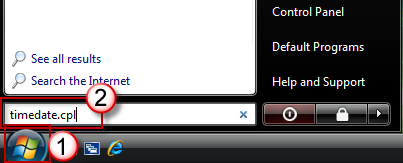
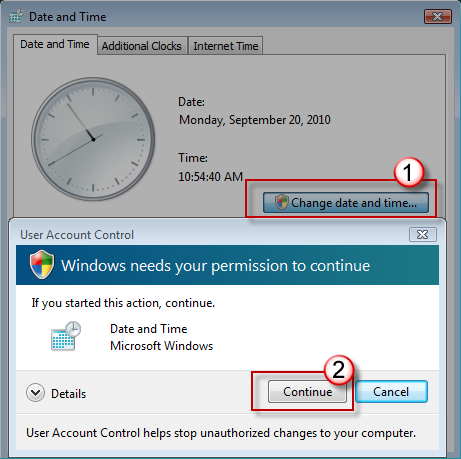
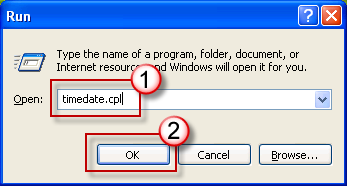
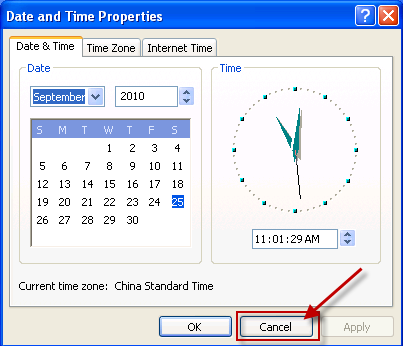

 , type cmd in the Search box or click Run then type cmd in the dialog (Windows XP or Windows Server 2003), and then press Enter to open a Command Prompt window.
, type cmd in the Search box or click Run then type cmd in the dialog (Windows XP or Windows Server 2003), and then press Enter to open a Command Prompt window. If you are prompted for an administrator password or confirmation, type the password, or provide confirmation.
If you are prompted for an administrator password or confirmation, type the password, or provide confirmation.